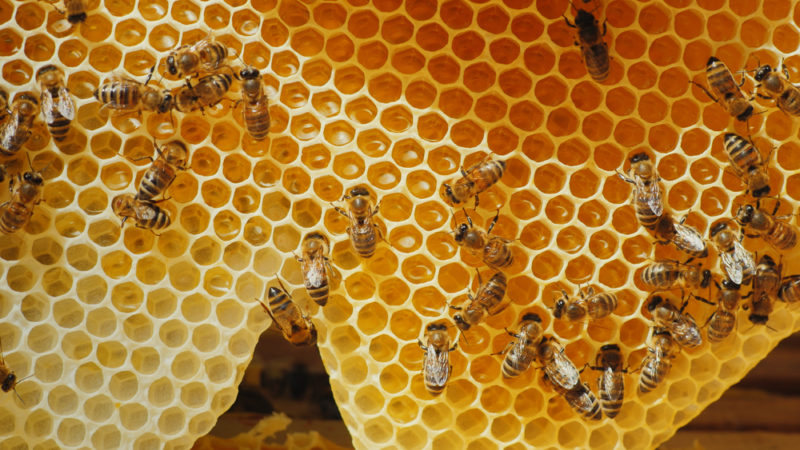Beehive construction material might just be the health treatment you’ve been looking for. Really! Propolis, or bee glue, is a natural resin-like substance in bee hives that has some amazing properties.
Honeybees use propolis as a kind of cement that seals cracks and open spaces in the hive to protect the hive. People have been using this bee glue for centuries as home remedies, toothpastes, creams, ointments, drops, and dietary supplements.
Common Names:
Propolis
Bee glue
Bee putty
Propolis wax
Propolis resin
At high temperatures, this substance is soft, pliable, and very sticky, like putty. At low temperatures it becomes hard and brittle. But honeybees don’t produce the propolis itself. Actually, they collect it from tree buds or other botanical sources. It is thought that the best sources of propolis are species of poplar, willow, birch, elm, alder, beech, conifer, and horse-chestnut trees.
Amazingly, bee glue appears to also act as an antiseptic preventing microbial infection of larvae, honey stores, and the combs. Whether the bees know about these germ-fighting properties, that is anyone’s guess. It is well established that bees around the world are constantly fighting off illness. The confined quarters and bee behavior make for the perfect conditions for viruses and disease to spread. Fortunately, the bees’ manufacturing and use of propolis reduces microbial growth on hive walls where combs are attached and also controls airflow, maintaining a consistent humidity inside the hive.
But propolis has beneficial properties for humans and not just bees!

The history of the use of bee products can be traced back to 13,000 BC, and our historical knowledge of propolis goes back to about 300 AD. There are records suggesting that ancient Egyptians, Persians, and Romans all used it. For example, ancient Egyptians depicted propolis-making bees on vases and other ornaments and used it to alleviate many ailments. The Ancient Jews considered tzori (the Hebrew word for propolis) as a medicine. In fact, tzori and its therapeutic properties are mentioned throughout the Old Testament chapters of the Bible.
In the Middle Ages, propolis was not popular and its use in mainstream medicine soon disappeared. Only a few manuscripts dealing with bee products have survived.
In the 21st Century, bee glue made quite the comeback and is now available to the masses.
Beneficial Properties of Propolis
Researching and observing 50,000 patients treated with bee glue over 20 years in the 1960’s and 1970’s, Dr. Karl Lung Aagaard, known as Dr. Propolis, found that a variety of conditions benefited from bee glue:
“The field of influence of Propolis is extremely broad. It includes cancer, infection of the urinary tract, swelling of the throat, gout, open wounds, sinus congestion, colds, influenza, bronchitis, gastritis, diseases of the ears, periodontal disease, intestinal infections, ulcers, eczema eruptions, pneumonia, arthritis, lung disease, stomach virus, headaches, Parkinson’s disease, bile infections, sclerosis, circulation deficiencies, warts, conjunctivitis and hoarseness.”
Since then, contemporary studies have confirmed certain benefits and found others such as eliminating parasites, improving fertility for females with endometriosis, and stop cold sore reproduction. The reputable Memorial Sloan Kettering Cancer Center includes this list of benefits on its Integrative Medicine pages and describes a few exceptions and areas where more research in needed:
- Cancer
- Cancer treatment-related oral ulcerations (mucositis)
- Diabetes
- Heart disease
- Infections
- Inflammation

Does harvesting propolis harm bees?
Like other honey products, the use of bee glue is controversial. The People for the Ethical Treatment of Animals are opposed to its use in any form because “bees are often left unprepared to survive harsh winters, unable to fight off diseases, or worse” and for many other reasons like the stress caused and loss of life to bees.
Undeniably, producing honey for human consumption kills bees, though there are ways to minimize loss of life. For beekeepers who find other ways to protect the bees to survive winter and fight off diseases, they believe that harvesting bee glue, if done properly, does not harm bees more than other types of honey production.
To harvest bee glue, beekeepers simply scrape frames, lids, and hive boxes. One beekeeper reports that when she harvests the substance in this manner, she is “careful not to also scrape up bee parts, paint, or wood…it saves me time gathering the purist of propolis.” As an alternative, placing a propolis trap inside the hive makes harvesting easier. Some companies report they never remove any propolis from the brood box where the larvae and queen live in order to reduce the harm to bees.
How to Take Propolis
You can easily find home care products that use bee glue, including home remedies, toothpastes, creams, ointments, drops, and dietary supplements. Whether you use it internally or topically, find a good, ethical source of propolis. If you use it internally, then look for extracts, tinctures, capsules, and tablets, or you could even consume it raw. For topical needs, find creams, sprays, ointments, powders, and balms. For detailed descriptions of the quantities and frequency for certain ailments visit here and here.
But also be careful. Sloan Kettering warns that allergic reactions to bee products have been reported. Therefore, patients who are allergic to bee venom (i.e., bee stings), honey, ragweed, or chrysanthemum should not take these supplements. Bee pollen may increase the side effect of warfarin, a blood thinning drug.
Sources:
Memorial Sloan Kettering Cancer Center
U.S. Environmental Protection Agency
National Institutes of Health
Basic Beekeeping Blog
University of Michigan – Medicine


